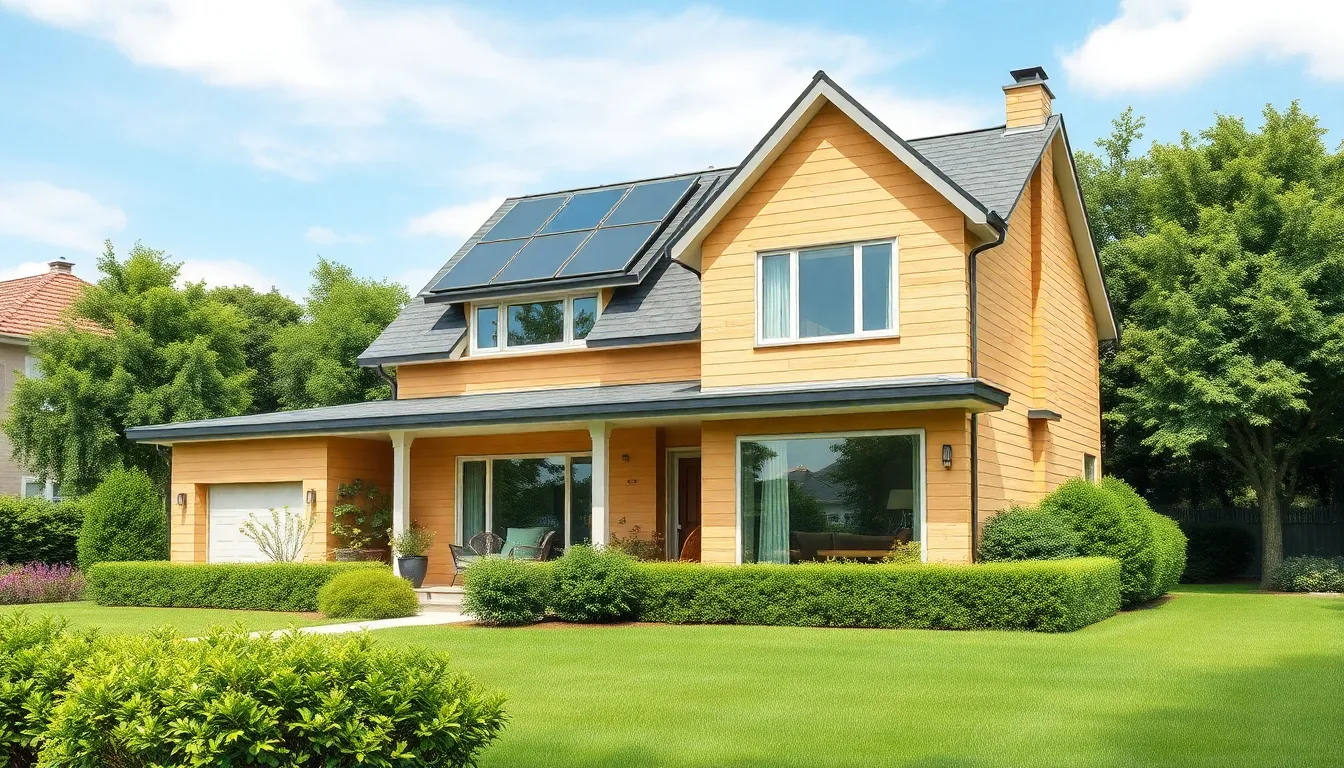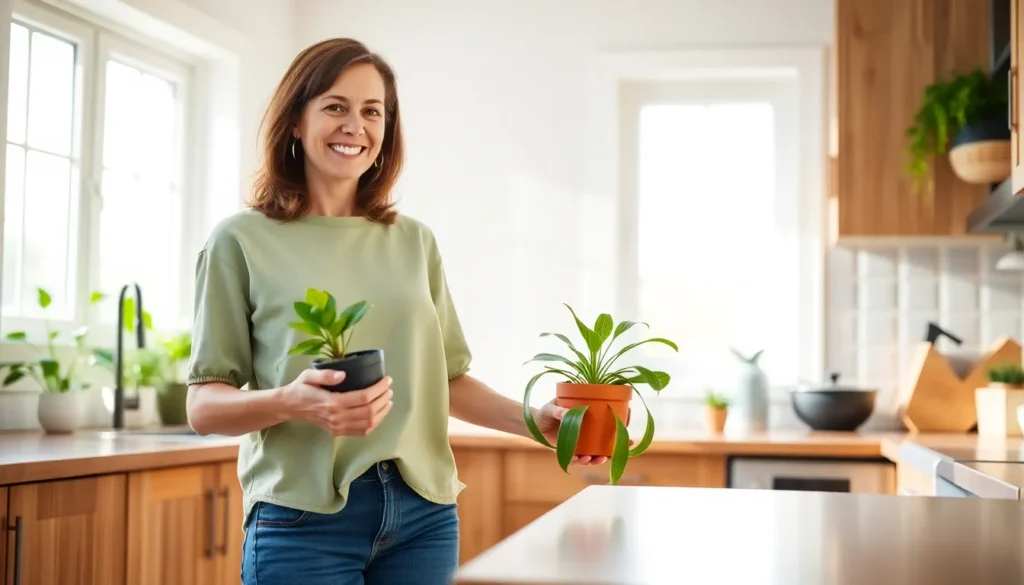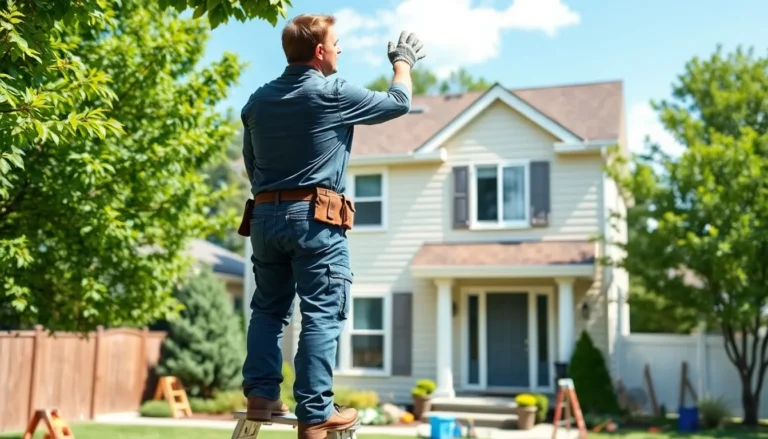In a world where the planet seems to be throwing a tantrum, making sustainable choices at home isn’t just trendy—it’s essential. Imagine a home that not only looks good but also does good. By adopting a few simple sustainable practices, anyone can transform their living space into an eco-friendly haven.
From swapping out light bulbs to embracing the power of plants, these tips make going green feel less like a chore and more like an adventure. Who knew saving the planet could come with such a side of humor? With a sprinkle of creativity and a dash of commitment, anyone can create a sustainable home that’s as stylish as it is responsible. So, let’s dive into some easy, actionable tips that’ll have your home looking fabulous while giving Mother Earth a well-deserved hug.
Table of Contents
ToggleUnderstanding Sustainability in Home Design
Sustainability in home design focuses on creating spaces that minimize environmental impact while maximizing efficiency. Incorporating eco-friendly materials like bamboo or reclaimed wood supports sustainable practices because these resources reduce waste and carbon footprints.
Energy efficiency plays a crucial role in sustainable homes. Utilizing LED lighting or Energy Star appliances can significantly lower electricity consumption, contributing to both environmental health and lower utility bills. Water conservation features, such as low-flow faucets and rainwater harvesting systems, enhance sustainability while promoting responsible usage of natural resources.
Selecting sustainable building materials matters because it influences the home’s overall environmental performance. Non-toxic paints and finishes improve indoor air quality, making the living space healthier. Prioritizing insulation during construction or renovation improves energy retention, leading to less reliance on heating and cooling systems.
Designing for longevity ensures that homes remain functional and attractive over time. Choosing timeless architecture reduces the need for frequent renovations, aligning with sustainable practices. Natural ventilation systems can help maintain comfortable indoor temperatures without resorting to mechanical solutions.
Integrating native landscaping contributes to a sustainable home environment by supporting local ecosystems. Planting native species requires less water and maintenance, fostering biodiversity and enhancing the surrounding environment. Additionally, installing solar panels harnesses renewable energy, reducing dependence on fossil fuels.
Making sustainable choices in home design creates a positive impact on the planet. Each decision, from material selection to energy-efficient systems, contributes to a more responsible living space that benefits both individuals and the environment.
Energy Efficiency Tips

Energy efficiency plays a vital role in creating a sustainable home. Implementing specific strategies can significantly reduce energy consumption and lower utility bills.
Insulation and Windows
Maximizing insulation improves a home’s thermal efficiency. Homeowners should consider upgrading insulation in attics, walls, and floors to prevent energy loss. Installing double or triple-pane windows enhances insulation and reduces heating and cooling demands. Utilizing window films or shades also prevents heat from entering or escaping. Lower energy costs result from these simple improvements.
Energy-Efficient Appliances
Choosing energy-efficient appliances significantly impacts household energy use. Selecting appliances with the Energy Star label ensures lower electricity consumption. Refrigerators, washers, and dishwashers designed for efficiency use less water and energy. Regular maintenance also extends the lifespan of these appliances. Homeowners notice a decrease in utility bills while using modern technology for convenience and sustainability.
Water Conservation Strategies
Water conservation plays a key role in creating sustainable homes. Implementing effective strategies helps reduce water usage and lowers utility bills.
Rainwater Harvesting
Rainwater harvesting involves collecting rainwater from roofs and surfaces to use for irrigation or household needs. Systems can vary; some homeowners opt for barrels placed under downspouts, while others invest in more complex setups that include storage tanks. This method helps alleviate pressure on municipal systems, making it an effective strategy for conserving fresh water. The average home can save over 1,500 gallons of water yearly with a basic rainwater collection system. Utilizing rainwater not only promotes conservation but also contributes to landscape health.
Low-Flow Fixtures
Low-flow fixtures significantly reduce water consumption in homes. Installing aerators on faucets can cut water use by up to 50 percent without sacrificing pressure. Additionally, low-flow showerheads provide a satisfying shower experience while using less than 2.5 gallons per minute. Replacing conventional toilets with high-efficiency models further enhances conservation efforts, as they use only 1.28 gallons per flush. These simple updates enhance comfort while ensuring sustainable water usage in everyday activities. Adopting low-flow fixtures not only conserves water but also contributes to lower water bills.
Sustainable Materials for Home Renovation
Sustainable materials play a crucial role in home renovation, helping reduce ecological footprints while enhancing living spaces. Using these materials fosters a healthier environment, both indoors and outdoors.
Recycled and Upcycled Materials
Recycled materials like glass, metal, and plastics offer versatile options for renovations. They help divert waste from landfills, significantly reducing overall environmental impact. Upcycled items, such as reclaimed wood or vintage fixtures, add unique character to spaces. Many homeowners appreciate the aesthetic appeal of bespoke designs created from these materials. Salvaged bricks or tiles can serve as stunning focal points while lowering carbon emissions linked to new production. Incorporating these materials not only benefits the planet but also promotes creative expression in home design.
Non-Toxic Paints and Finishes
Choosing non-toxic paints and finishes leads to healthier indoor air quality. Traditional paints often contain volatile organic compounds (VOCs), which may cause respiratory issues. Numerous brands now offer low-VOC or zero-VOC alternatives, ensuring safer environments for families. Environmentally friendly finishes, like natural oils or water-based sealants, protect surfaces without harming residents. Opting for these products reduces the risk of harmful fumes, creating inviting living spaces. Consumers often find a range of colors and textures available in eco-friendly options, allowing for stylish, sustainable choices.
Eco-Friendly Landscaping
Eco-friendly landscaping enhances home sustainability while supporting local ecosystems. Selecting appropriate plant species and maintaining natural habitats contributes significantly to environmental health.
Native Plant Gardening
Utilizing native plants fosters biodiversity and promotes harmony with local ecosystems. These plants require less water and fertilizer, making maintenance simpler and more sustainable. They also offer essential habitats for pollinators like bees and butterflies. Examples include lavender or goldenrod, which thrive in local soils. Incorporating them into gardens attracts native wildlife and supports regional resilience against pests. Planning native plant gardens creates a vibrant landscape that flourishes with minimal resource input.
Sustainable Lawn Care Practices
Implementing sustainable lawn care practices reduces environmental impact and conserves resources. Mowing at higher grass heights encourages deeper root growth and less water usage. Choosing organic fertilizers over chemical alternatives protects soil health and reduces runoff pollution. Additionally, regular aeration helps improve water absorption while preventing compaction. Replacing traditional grass with drought-resistant ground covers, such as clover or creeping thyme, decreases watering needs significantly. Adopting these practices leads to lush, green lawns that benefit both the homeowner and the environment.
Embracing sustainable living at home is a rewarding journey that benefits both the planet and its inhabitants. Every small change contributes to a larger impact, making eco-friendly choices accessible to everyone. By integrating energy-efficient appliances, water conservation methods, and sustainable materials, homeowners can create healthier environments.
This commitment to sustainability not only enhances the aesthetic appeal of a home but also promotes long-term savings. As individuals navigate their unique paths toward greener living, the focus should remain on creativity and enjoyment. Ultimately, these sustainable practices pave the way for a brighter future, ensuring that homes are not just places to live but also spaces that nurture the Earth.




